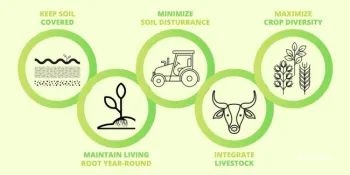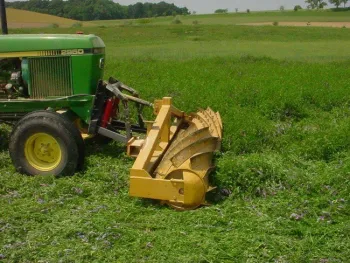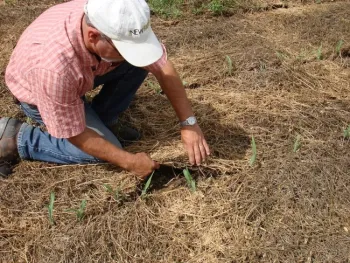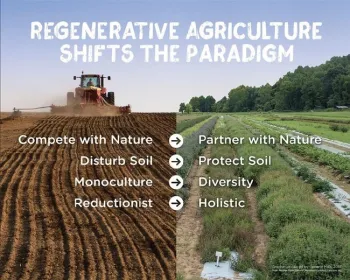
Today, industrial agriculture and traditional gardening techniques can mistreat soil, often with synthetic chemicals. Soils have been depleted throughout the past years through the conventional agriculture practices of tilling, carbon mining, and salt-based fertilizers and pesticides that harm life in the ground, releasing carbon into the air - changing farms and gardens into sources of carbon emissions. Conversely, soil and microorganisms can hold a vast amount of carbon with good management practices by growing food more in harmony with nature.
We often think carbon is something dangerous because we associate it with climate change. However, it is the building block for all life. In the atmosphere as carbon dioxide, carbon produces a greenhouse effect that heats the planet, but plants use carbon to create cells to grow and feed microorganisms in the soil that supports them. Therefore, the principles of regenerative agriculture aim to reverse these adverse effects by following rigorous guidelines, which include using cover crops, reducing tilling, rotating yields, spreading compost, and moving away from synthetic fertilizers, pesticides, herbicides, and factory farming.
Regenerative agriculture is a holistic land management practice that uses photosynthesis in plants to sequester carbon in the soil while improving soil health, crop returns, water resilience, and nutrient density.

Consequently, regenerative agriculture is the conservation of land through practices that improve our soil, preserve our water, and enhance biodiversity. These processes often copy those found in nature, and with a shift of behavior, farmers and home gardeners can lessen and ultimately eliminate their dependence on pesticides and fertilizers.
Moreover, regenerative practices not only apply to the agricultural system; they can be implemented in our home gardens by applying the techniques used by regenerative agriculture. These practices will enable the home gardener to increase the organic matter in the soil, which in turn will introduce more nutrients into their crops, providing habitat for wildlife, offer a safe space to return to nature, as well as take action against climate change while making their garden more resilient to its effect.
Even though creating and using compost is a vital place to start, we can also consider other practices to enhance our soils and sustain the ecosystem. Keeping in mind that good soil practices are the foundation of gardening regeneratively, here are some regenerative principles home gardeners can implement in their gardens.
No-till/minimum tillage. Tillage destroys soil mass and fungal communities while adding excess O2 to the soil for increased respiration and CO2 emission. It can be one of the most destructive agricultural practices, which results in increased soil erosion and carbon loss. Consequently, no tilling/minimum tillage enhances soil mass, water filtration and

Soil fertility growth increases in regenerative systems organically through the application of cover crops, crop rotation, compost, mulches, and animal manures, restoring the plant/soil microbiome to promote the release, transfer, and cycle of essential soil nutrients. In addition, to prevent erosion, several university studies have shown that mulching can improve the growth of plants by improving soil-moisture availability due to reduced weed competition and reduced evaporation from the soil surface.
On the other hand, artificial fertilizer creates imbalances in the microbial communities in soil, creating dependency and weaker, less resilient plants. Moreover, research has established that synthetic fertilizer promotes climate change through the energy cost of production and transportation, chemical breakdowns and penetration into water supplies and the atmosphere, the alteration of soil microbial communities, and accelerating decomposition of soil organic matter.
Furthermore, building natural ecosystem diversity begins with the injection of soils with compost or compost extracts to reinstate soil microbial community population, structure, and activities. Next, they restore soil system vitality through full-time planting of multiple crops, intercrops planting, multispecies, and cover crops. Some examples of cover crops that are not for consumption but shield the soil are mustard, alfalfa, rye, clover, and others. Also, border planting for bees' habitats and other beneficial insects is essential. A garden or farm full of diversity in plant material will invite a wide array of beneficial insects and pollinators, strengthening its overall resiliency while reducing the need for pesticides.
Maximizing living roots in the soil year-round nourishes microbes by providing a food source or by releasing nutritious compounds into the ground. It has been estimated that plants realize from 10 to 40 percent of the carbon fixed by photosynthesis through the roots. This carbon increases soil organic matter.

Good, coordinated, grazing practices help improve plant growth, increase soil carbon deposits, and increase overall pasture and grazing land productivity while significantly increasing soil fertility, insect and plant biodiversity, and soil carbon sequestration. In addition, good practices improve ecological health and the health of the animal and human consumer by improving micro-nutrient availability and better dietary omega balance. Other advanced techniques include silvopasture (the intentional combination of trees, forage plants, livestock as an integrated, intensive management system) and agroforestry (the restoration of trees and tree crops on farms).
In summary, regenerative agriculture strives to limit chemical, physical and biological disturbance, keep the soil covered, add diversity of plants and insects, keep a living root in the ground as long as possible and integrate animals into your system. These self-healing, self-organizing and self-regulating principles enabled ecosystem health and function long before humans were on earth.
Regenerative agriculture means reversing the harm done to our soil and embracing agricultural practices that leave the land in better shape for future generations. But most importantly, regenerative practices in agriculture or a home garden offer the chance to build healthy communities.
For more information, please visit the follow sites
https://sarep.ucdavis.edu
https://www.csuchico.edu
https://regenerationinternational.org
https://www.nrcs.usda.gov
https://csanr.wsu.edu
www.nrdc.org
https://www.nrcs.usda.gov
https://regenerationinternational.org
https://greenamerica.org

